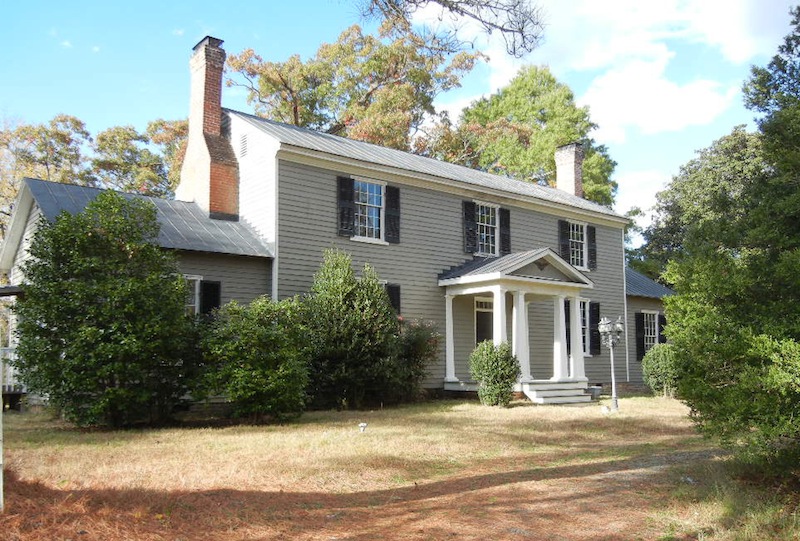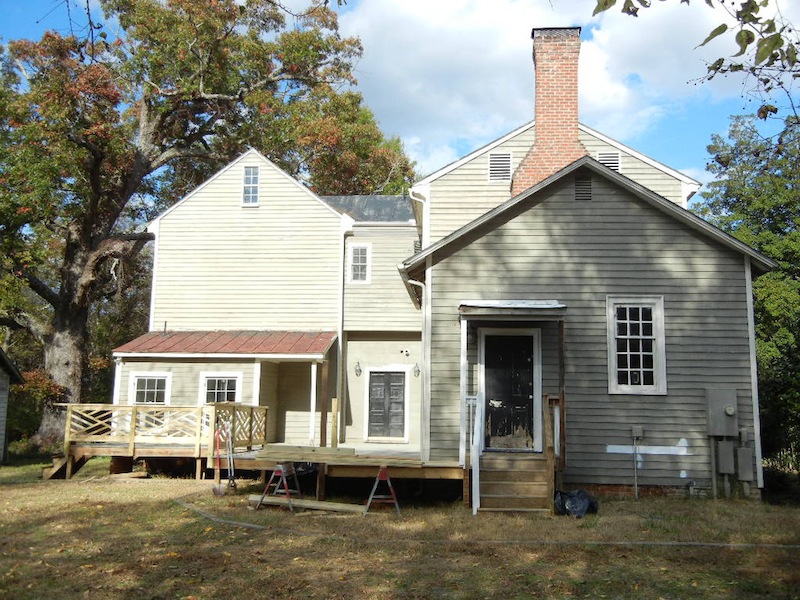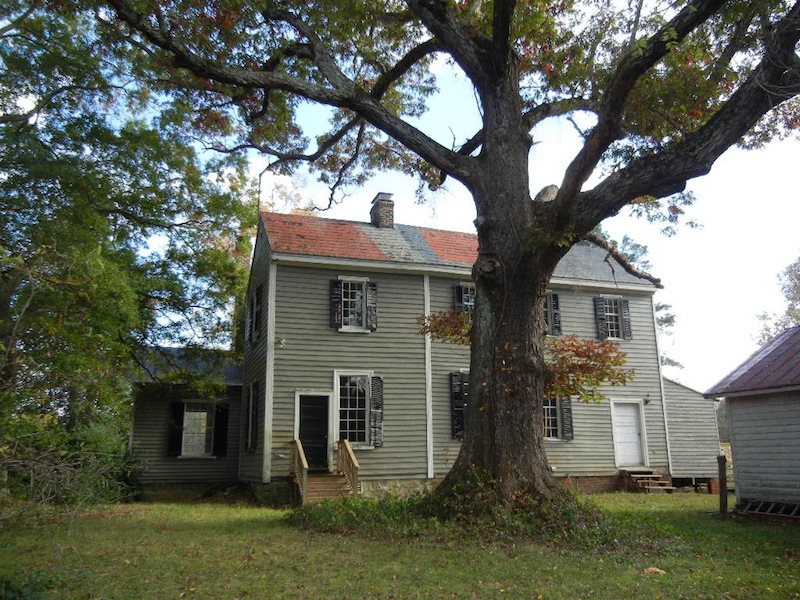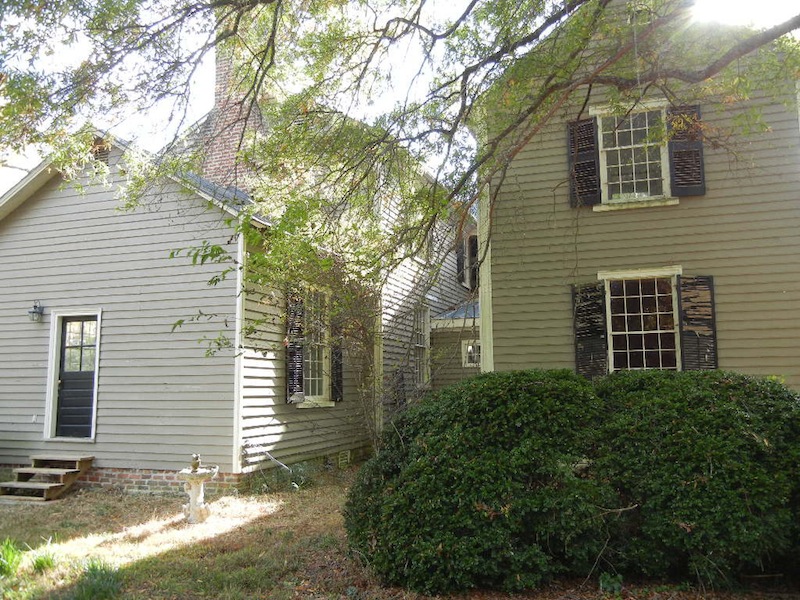Sunnyside
*National Register of Historic PlacesSunnyside is now operating as a restaurant.
104 Shiney Rock Road, Clarksville, Virginia
(434) 374-4200
Hours: Open for lunch and dinner Tuesday through Friday, and Sunday brunch.
Call for exact hours.
Sunnyside is an estate, including a multi-sectional plantation house, the earliest part of which was built in 1833 for Samuel Hester and Eliza Greenwood Hester, on property inherited from her father. A 1936 Sunnyside survey report, part of the Virginia W.P.A. Historical Inventory Project, indicates, however, that "the back of the house was originally an old inn in Revolutionary days" and that "the old turnpike road went past the well and the stage-coaches used to stop there to water their horses".
(434) 374-4200
Hours: Open for lunch and dinner Tuesday through Friday, and Sunday brunch.
Call for exact hours.
Tucker Carrington, local lawyer, politician, and a developer of Clarksville, acquired the Sunnyside property in 1836. Family correspondence suggests that the plantation was called Eglantine in the 1840s. It was during most of this decade that Carrington was a gentleman Justice of the Peace. In 1834 Carrington organized a tobacco show and fair in Clarksville with Sam Watkins and Paul Venable; this was advertised in the Richmond Enquirer. He owned several town lots in Clarksville, including the tract where the Royster tobacco warehouse was rebuilt in 1846. He was also among several men, under whose direction stock was to be sold, according to an act of March 4, 1851, incorporating the Roanoke Valley Railroad to run from Clarksville to near Ridgeway, North Carolina, to join the Raleigh and Gaston Railroad, thus providing a continuous line of railroad from Clarksville to Portsmouth, Petersburg and Richmond. He also served as a state senator from 1848 to 1853 and was one of the founders of the Bank of Clarksville in 1860.
In 1861 Carrington was one of the candidates for delegate to the Virginia Peace convention, and in this capacity he was the principal speaker at a large and lengthy public meeting in Boydton on January 21, 1861, on the subject of secession, which he favored.
Pages 293 and 294 of Susan Bracey's Life by the Roaring Roanoke offer the following about the Tucker Carrington home and the fate of one of Carrington's slaves, known as Fred, in connection with the June 1864 Wilson-Kautz Raid and Federal raiders: "As they moved across the county, they were able to enlist the aid of some of the slaves who saw the presence of the "Yankees" as an opportunity. Two slaves in Mecklenburg took advantage of this opportunity and were tried, in July, for conspiring to rebel. On the day after the attack on the railroad bridge, the Union cavalry went to the plantation of Tucker Carrington where, among other things, they picked up Fred, one of Carrington's slaves. As the invaders continued, Fred cheerfully accompanied them, intending to go 'wherever the Yankees went.' From Carrington's, the cavalry and Fred, now armed with a gun and wearing a new suit, moved to the plantation of Dr. John Boswell. Here they ordered that a meal be prepared for them. At this point, Fred made threats against the life of Dr. Boswell and told the Yankees where to find Boswell's hidden mules. Jesse, a slave of Rebecca Wagstaff, had been at the Boswell plantation visiting his wife when the raiders arrived and ordered him to give his assistance. At first Jesse had to be forced to help, but as the raiders reached the next house, that of Robert Burton, he was more cooperative. Here the Yankees broke into the house and stole sugar and clothing. Fred and Jesse became the benefactors of the clothing; Fred donned Burton's pantaloons and Jesse his great coat. It is not known how Fred and Jesse were captured by the Mecklenburg authorities. The slaves were tried for plotting an insurrection, for robbery, and for being armed. Fred was found guilty and was ordered to be hanged. Jesse was found not guilty of a felony, but guilty of a misdemeanor for which he received thirty-nine lashes.
As Wilson's raiders proceeded on their way, they were engaged by the Boydton Cavalry (and probably more of the 3rd Virginia) in Dinwiddie County." Page 295 of Bracey's book references "the problems of war" and Tucker Carrington as a member of Mecklenburg County's Committee of Safety: "In order to attempt to deal with the problems of war, the Virginia General Assembly passed on February 25, 1865, an act authorizing the Assembly to appoint Committees of Safety (of three men) in each county. Among its duties were: to get army supplies by sale or loan, to organize the collection of voluntary contributions of supplies for the army, to report on anyone who was hindering the shipment of army supplies, to report on deserters, and so on. The committee in Mecklenburg was composed of Tucker Carrington, Alfred Boyd, and John B. Northington." The following anecdote about Carrington's post-War life was recounted by Mr. and Mrs. A. P. Johnson of Clarksville to author Bessie Hester in 1936 when she was researching Sunnyside for the aforementioned Works Progress Administration inventory: "Soon after the War Between the States Mrs. Tucker Carrington begged her husband to put down a brick walk, but he told her he could not afford it at that time. However, she was determined to have it and saved her egg money until she had enough to pay for it. She often remarked that each brick in the walk represented an egg." A glimpse into Carrington's post-War life is also found on page 224 of Bracey's book: "In the years following the War, the county was repeatedly tantalized by prospects of the establishment of various new railroads." ... There were ... prospects and high hopes for the arrival of the Norfolk and Great Western Railroad which had been incorporated in February 1867." Among the men listed as "appointed to be in charge of subscriptions in Mecklenburg" is Tucker Carrington. The attempt to create the Norfolk and Great Western Railroad was unsuccessful.
An 1871 lawsuit resulted in the sale of the plantation property, but Carrington's daughters, Agnes and Emily, purchased the 450-acre tract. From 1871 to 1908, Carrington's four daughters operated the Misses Carringtons' Boarding and Day School for girls. It is reported that the name "Sunnyside" was given to the residence around 1871 when the Carrington sisters first advertised the Sunnyside School. The name Sunnyside first appeared in Mecklenburg County records in the 1894 will of Agnes W. Carrington. Page 337 of Bracey's book offers this on the school: "The opportunities for young ladies to receive an education increased after the war. ... On January 2, 1871, Sunnyside, or the Misses Carrington's Boarding and Day School, opened. It was run by Isabella, Mildred, Emily, and Agnes Carrington, daughters of Tucker and Mary Carrington, who owned 'Sunnyside'. Located a mile south of Clarksville, it was both a boarding and a day school. The school, which enjoyed a high reputation, closed in 1908." The National Register of Historic Places Inventory/Nomination form for Sunnyside offers these details about the school:
"The school roster included a few boarders from all over Virginia and North Carolina as well as a large number of day students from Clarksville. During the 1872-73 session there were eight boarders and more than twenty day pupils. Miss Agnes managed the farm and garden with overseer Uncle Billy, and Uncle Billy's wife, Aunt Anna, was the cook. Both Uncle Billy and Aunt Anna were former slaves who remained with the family after emancipation. Miss Emily taught mathematics, French, general grade work, and the Bible, Miss Belle taught music, and Miss Mildred taught art, history, and English. Outside teachers came in regularly to teach other subjects such as Latin and mathematics. The courses were divided into primary, intermediate, junior, and senior classes. The school, which continued until 1908, is significant in the history of education in the county as one of the finest, most highly respected and longest-functioning private girls schools in Mecklenburg County in the late nineteenth century." The above-mentioned nomination form also notes several domestic and agricultural buildings, including a late-nineteenth-century kitchen, an early-to-mid-nineteenth-century servant's quarter, an early-to-mid-nineteenth smoke house, a mid-nineteenth-century shed, and the site of a nineteenth-century ice pit.
In 2013 Sunnyside was purchased by Don and Ellen Koch who have converted it to a restaurant.
Contributor: Leigh Lambert, Director of Southside Regional Library
(c) Copyright 2014. All Rights Reserved. Designed by Jason Winter ||



